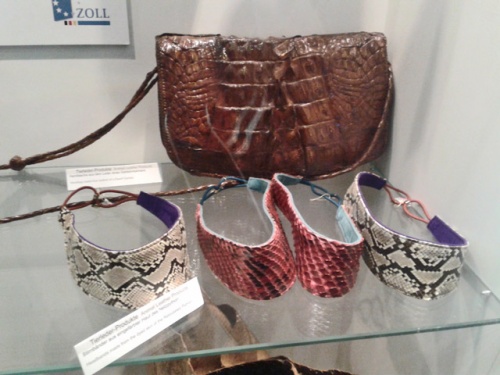CITES - Convention on International Trade in Endangered Species of wild fauna and flora
The Washington Convention on the Protection of Animals (CITES - Convention on International Trade in Endangered Species of wild fauna and flora) is an international agreement between 164 countries, which is to control the global trade in plants, animals and products made from them. The aim of the agreement, signed by eighty governments in Washington in 1973, is the protection of endangered species from extinction.
The agreement contains three lists of endangered species of plants and animals whose trade, even in processed form, is totally prohibited. This includes cacti, orchids, snails and corals, as well as ivory, caviar, tortoiseshell, and finally exotic leather, especially reptile leather, monitor lizard species, giant snakes, cobra varieties and peccary. On importation, such goods are confiscated by customs.
Examples of exotic leather seized by customs.
Frequently, exotic leather is obtained through inheritance. The subsequent sale of such an item can be classed as a criminal offence. Ebay & Co. exclude such leather objects from the trade. Without a species protection banner, a sale is prohibited. Therefore, it is usually advisable to keep these legally-obtained objects or to give them away or to consult an expert.
Objects clearly produced before 1973 may be traded under certain conditions. For this purpose, an expert opinion is required that confirms the age and determines the animal species. How this works has to found out in every individual country.
Fortunately, there is no big market for banned exotic leather. Unlike rhinoceros, etc., exotic leather is not known to promote potency. Therefore, there are no buyers, nor is there a collectors' community that would attempt to illegally acquire such leather items.
Most exotic leather objects come into circulation by the thoughtless purchase of souvenirs from long-distance trips. Beautiful corals or shells, or objects made of exotic leather or teeth of rare animals are offered on tourist markets. Be careful! The penalties are very high and these objects are confiscated.
CITES certificate
Legitimately-treated reptile leather may be recognised by the CITES certificate, which is issued abroad. The CITES certificate should always be kept with the objects to prove legal possession.
Legally imported reptile leather comes from reptile farms such as the Samut Prakarn farm in Bangkok, Thailand, where 20,000 reptiles are kept on 400,000 square meters and about 10,000 hides are produced each year. A farm of comparable size is also located in Mombasa, Kenya.

Fictitious example of the code on a reptile species banner. From top left to bottom right:
87 = Year of issue of the CITES certificate, here 1987
09969 = CITES-number
DE = Release county of the CITES, here Germany
1 = position 1=A on the CITES-form
103 = Species key, here Caiman c. yacare
US = Country of production of the article, here USA
30 = Article group, here watch strap
42 = Customer number assigned by the reptile species protection
00459 = Current number of operations in the reptile species identification system (IRV-number)
A CITES certificate is required when purchasing leather from alligators, crocodiles, many lizard species, giant snakes, peccaries or elephants, but also for many other species.
According to a 2022 report, the Washington Convention on International Trade in Endangered Species has meant that today around 65% (by estimated value) of endangered species leather comes from breeding farms and only 24% from wild animals that have been legally hunted. In particular, the populations of American alligators, Asian water monitors and pythons from Vietnam have been stabilized or even increased.
Video about leather of different animal species
Leather of different animal species - Exotic leather.
Additional information
- Exotic leather
- Fur
- Taxidermy - Hunting trophies - Mounted animals
- PeTA - People for the Ethical Treatment of Animals
- Leather sustainability and traceability










 a kotori web solution
a kotori web solution